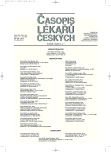Postgenomic era, what comes after?
Authors:
R. Brdička
Authors‘ workplace:
Ústav hematologie a krevní transfuze, Praha
2
Published in:
Čas. Lék. čes. 2010; 149: 315-318
Category:
Topic
Overview
Though we start to speak about postgenomic era, the genomic era has not been finished yet and the structure, function and variability of our genome is being still intensively studied and these studies bring us continually new scientific information – more than we are able to digest. The classical genetics utilized phenotype observation for discovering the function of genetic information and proceeded to the molecular basis represented by nucleic acids. Determination of the nucleotide sequence of the human genome is the top outcome of the effort. At present, the function, regulatory pathways and genome modifications have become principal targets of our research. If we compare variability, it increases in the direction from human genome to transcriptome and to proteom reaching the highest level in phenome. Differences concern not only quantity, but also quality with the exception of genome which is relatively stable and „we hand over to our children what we have inherited from our parents“ - all other levels undergo dynamic changes, and from this point of view are much less stable and under continuous influence of environment. To understand enviromental factors shaping our phenome, a long-term monitoring of our living functions will be necessary and an instrumental approach has to be looked for.
Key words:
genome, transcriptome, proteome, phenome, epigenetics methylome, chromatin remodelling.
Sources
1. Mabaera R, et al. Neither DNA hypomethylation nor changes in the kinetics of erythroid differentiation explain 5-azacytidine’s ability to induce human fetal hemoglobin. Blood 2008; 111: 411–420.
2. Claus R, et al. Targets of epigenetic therapy – Gene reactivation as a novel approach in MDS treatment. Cancer Treatment Reviews 2007; 33(Suppl 1): S47–S52.
3. Yamanaka K, et al. Gene silencing of DNA methyltransferases by RNA interference in bovine fibroblast cells. Journal of Reproduction and Development 2010; 56: 60–67.
4. Flanagan JM, et al. DNA Methylome of Familial Breast Cancer Identifies Distinct Profiles Defined by Mutation Status. American Journal of Human Genetics 2010; 86: 420–433.
5. Smith EM, et al. The potential role of epigenetic therapy in multiple myeloma 2010. British Journal of Haematology 2010; 148: 702–713.
6. Vlaicu SI, et al. Epigenetic modifications induced by RGC-32 in colon cancer. Experimental and Molecular Pathollogy 2010; 88: 67–76.
7. Martín V, et al. Epigenetic regulation of the non-canonical Wnt pathway in acute myeloid leukemia. Cancer Science 2010; 101: 425–432.
8. An JY, et al. UBR2 mediates transcriptional silencing during spermatogenesis via histone ubiquitination. PNAS 2010; 107: 1912–1917.
9. Chikhirzhina GI, et al. Transcription factors of the nuclear factor 1 (NF1) family. Role in chromatin remodelation. Molekuliarnaia biologiia 2008; 42: 388–404.
10. Shukla MS, et al. RSC generated non-mobilized particles with approximately 180 bp DNA loosely associated with the histone octamer. PNAS 2010; 107: 1936–1941.
11. Lorch Y, et al. Mechanism of chromatin remodeling. PNAS 2010; 107: 3458–3462.
12. Toguchida J, Nakayama T. Molecular genetics of sarcomas: applications to diagnoses and therapy. Cancer Science 2009; 100: 1573–1580.
13. Arici DS, et al. Expression of retinoblastoma and cyclin D1 in gastric carcinoma. Neoplasma 2009; 56: 63–67.
14. Mohammed AM, et al. Constitutional retinoblastoma gene deletion in Egyptian patients. World Journal of Pediatrics 2009; 5: 222–225.
15. Chen D, et al. The p53 pathway promotes efficient mitochondrial DNA base excision repair in colorectal cancer cells. Cancer Research 2006; 66: 3485–3494.
16. Gorduza EV, et al. Nutrigenomics in postgenomic era. Revista medico-chirurgicala. Soc Med Nat I 2008; 112: 152–164.
17. Ghosh D. Personalised food: How personal is it? Genes and Nutrition 2010; 5: 51–53.
18. de Vrieze J, et al. Nutrition Tailored to the Individual? Not Just Yet – Realigning Nutrigenomic Science with Contemporary Society. Journal of Nutrigenetics and Nutrigenomics 2010; 2: 184–188.
19. Dragsted LO. Biomarkers of meat intake and the application of nutrigenomics. Meat Science 2010; 84: 301–307.
20. Singh N, et al. NanoGenotoxicology: The DNA damaging potential of engineered nanomaterials. Biomaterials 2009; 30: 3891–3914.
21. Topinka J, et al. Biomarkers of exposure to tobacco smoke and environmental pollutants in mothers and their transplacental transfer to the foetus. Part I: bulky DNA adducts. Mutat Res 2009; 669: 13–19.
22. Tarazona JV, et al. Targeting the enviromental risk assesment of pharmaceuticals: facts and fantasies. Integr Environ Assess Manag 2009; 6.
23. Arber W. Systemic aspects of biological evolution. Journal of Biotechnology 2009; 144: 242–244.
24. Matthews SG, Phillips DIW. Minireview: Transgenerational inheritence of the stres response: A new frontier in stress research. Endocrinology 2010; 151: 7–13.
25. Arbour C a Gélinas C. Are vital signs valid indictors for the assesment of pain in postoperative cardiac surgery ICU adults? Intensive and Critical Care Nursing 2010; 26: 83–90.
26. Bender JE, et al. Nonivasive monitoring of tissue hemoglobin using UV-VIS diffuse reflectance. Optics Express 2010; 17: 23396–23409.
27. Busis. Mobile phones to improve the practice of neurology. Neurologic Clinic 2010; 28: 395–410.
Labels
Addictology Allergology and clinical immunology Angiology Audiology Clinical biochemistry Dermatology & STDs Paediatric gastroenterology Paediatric surgery Paediatric cardiology Paediatric neurology Paediatric ENT Paediatric psychiatry Paediatric rheumatology Diabetology Pharmacy Vascular surgery Pain management Dental HygienistArticle was published in
Journal of Czech Physicians

Most read in this issue
- Gallstone ileus – the diagnostic and therapeutic challenge
- Mast cells – a new view of the old acquaintances
- Alterations in fatty acid composition of plasma and erythrocyte lipids in critically Ill patients during sepsis
- The prevalence of metabolic syndrome in women with polycystic ovary syndrome
